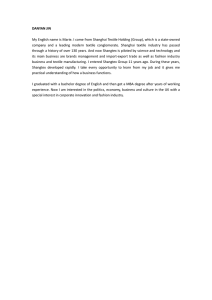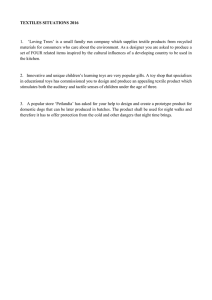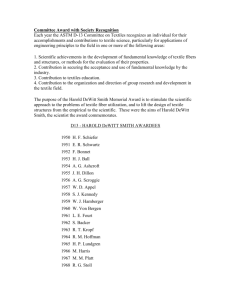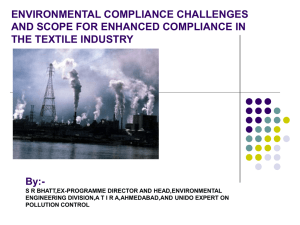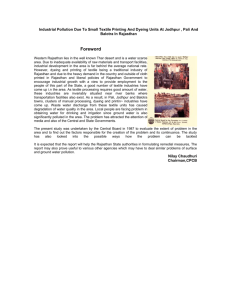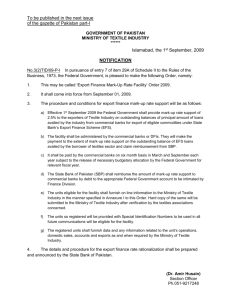Document 14248950
advertisement
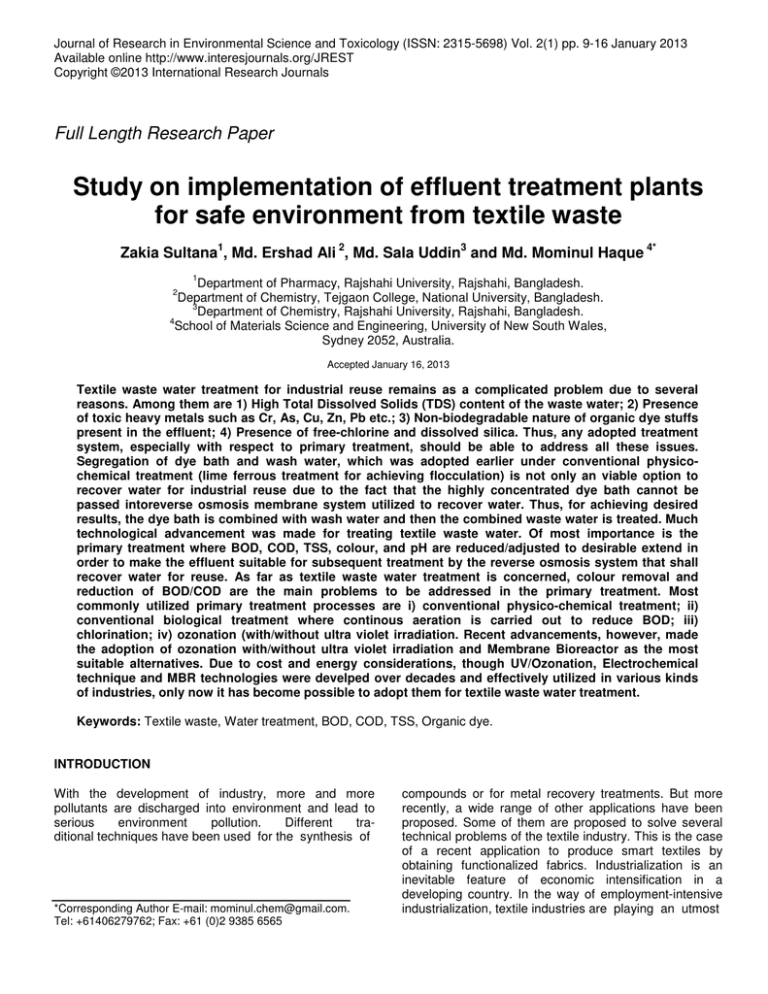
Journal of Research in Environmental Science and Toxicology (ISSN: 2315-5698) Vol. 2(1) pp. 9-16 January 2013 Available online http://www.interesjournals.org/JREST Copyright ©2013 International Research Journals Full Length Research Paper Study on implementation of effluent treatment plants for safe environment from textile waste Zakia Sultana1, Md. Ershad Ali 2, Md. Sala Uddin3 and Md. Mominul Haque 4* 1 Department of Pharmacy, Rajshahi University, Rajshahi, Bangladesh. Department of Chemistry, Tejgaon College, National University, Bangladesh. 3 Department of Chemistry, Rajshahi University, Rajshahi, Bangladesh. 4 School of Materials Science and Engineering, University of New South Wales, Sydney 2052, Australia. 2 Accepted January 16, 2013 Textile waste water treatment for industrial reuse remains as a complicated problem due to several reasons. Among them are 1) High Total Dissolved Solids (TDS) content of the waste water; 2) Presence of toxic heavy metals such as Cr, As, Cu, Zn, Pb etc.; 3) Non-biodegradable nature of organic dye stuffs present in the effluent; 4) Presence of free-chlorine and dissolved silica. Thus, any adopted treatment system, especially with respect to primary treatment, should be able to address all these issues. Segregation of dye bath and wash water, which was adopted earlier under conventional physicochemical treatment (lime ferrous treatment for achieving flocculation) is not only an viable option to recover water for industrial reuse due to the fact that the highly concentrated dye bath cannot be passed intoreverse osmosis membrane system utilized to recover water. Thus, for achieving desired results, the dye bath is combined with wash water and then the combined waste water is treated. Much technological advancement was made for treating textile waste water. Of most importance is the primary treatment where BOD, COD, TSS, colour, and pH are reduced/adjusted to desirable extend in order to make the effluent suitable for subsequent treatment by the reverse osmosis system that shall recover water for reuse. As far as textile waste water treatment is concerned, colour removal and reduction of BOD/COD are the main problems to be addressed in the primary treatment. Most commonly utilized primary treatment processes are i) conventional physico-chemical treatment; ii) conventional biological treatment where continous aeration is carried out to reduce BOD; iii) chlorination; iv) ozonation (with/without ultra violet irradiation. Recent advancements, however, made the adoption of ozonation with/without ultra violet irradiation and Membrane Bioreactor as the most suitable alternatives. Due to cost and energy considerations, though UV/Ozonation, Electrochemical technique and MBR technologies were develped over decades and effectively utilized in various kinds of industries, only now it has become possible to adopt them for textile waste water treatment. Keywords: Textile waste, Water treatment, BOD, COD, TSS, Organic dye. INTRODUCTION With the development of industry, more and more pollutants are discharged into environment and lead to serious environment pollution. Different traditional techniques have been used for the synthesis of *Corresponding Author E-mail: mominul.chem@gmail.com. Tel: +61406279762; Fax: +61 (0)2 9385 6565 compounds or for metal recovery treatments. But more recently, a wide range of other applications have been proposed. Some of them are proposed to solve several technical problems of the textile industry. This is the case of a recent application to produce smart textiles by obtaining functionalized fabrics. Industrialization is an inevitable feature of economic intensification in a developing country. In the way of employment-intensive industrialization, textile industries are playing an utmost 10 J. Res. Environ. Sci. Toxicol. Important role offering tremendous opportunities for the economy of Bangladesh. But, hasty and unplanned clustered growth of industries leads to adverse environmental consequence in an alarming way. Large quantity of water associated with the production of a number of dyeing and textile industries, releases toxic wastewater rich in dye and chemicals to the environment that result in severe water-body pollution. These untreated industrial effluents not only deteriorate surface water quality, ground water, soil, vegetation, but also cause many water borne diseases that is threatening to public health. Therefore, treatment facility for such wastewater is strictly recommended within the industry. But, in developing countries like Bangladesh, where less attention is paid to environmental protection, environmental regulations are not effectively implemented and pollution control techniques are not yet fully developed. In this situation, pollution and the public health problem caused by the textile/ dyeing along with other industries in Bangladesh has been the focus recently and the gravity of installation of Effluent Treatment Plant (ETP) has drawn attention. Amid huge public criticism against textile dyeing and processing units for polluting water-bodies and farmland by releasing toxic chemical wastes, the government is trying to deal with the matter by setting deadlines to pressure the industries to set up ETPs. Thus, industries have to continue to progress in meeting environmental obligations by undertaking anti-pollution measures. As, a large number of factories are operating without the ETPs, violating the existing laws, it has become a challenge for Government and private sector to work together to promote ETP installation with clear understanding the gravity of the problem and to take necessary steps by giving proper attention to all aspects. Textile industry in Bangladesh The textile and apparel industry in Bangladesh occupies a prominent position within the country’s industrial structure. It is the largest manufacturing sector, providing jobs for some 50% of the total industrial workforce and contributing 9.5% of the country’s GDP. Also, it accounts for almost 77% of total exports, making it Bangladesh’s leading foreign exchange earner (http://www.researchandmarkets.com). In the early 1980s exports were dominated by jute while garment sales were insignificant. But today garment exports are by far the leading export category. In 2001/02 the clothing sector generated as much as US$4.58 billion in foreign exchange (http://www.researchandmarkets.com). The industry benefits from special access to markets in the EU, Canada, Norway and Japan. Because Bangladesh is a least developed country, its textile and clothing exports enter these countries quota-free and duty-free. This concession, together with low labor costs, provides the garment sector with a strong competitive advantage (http://www.researchandmarkets.com). Knitwear sector’s contribution was 7.64% of the readymade garments sector (RMG) sector in 1990-91. It has shown to 49.43% in 2006-07. Last year knitwear export was over US$ 4.5 billion comprising 37.39% of the total export earning of Bangladesh. The RMG sector earned about 75.6% of the total export earning in 20062007, a major share of this is from the export of knitwear (Karim, 2007). Thus, these textile industries have established itself as important sub-sector in the national economy. Despite this fact, those impose socio-economic deprivation of the people of surrounding communities by polluting the environment. So, it is high time, industries should take remedy measures to build public confidence and demonstrate that they are also for protecting environment. Not only to meet the local laws, but also to meet the buyer’s requirement regarding environmental compliance, they can’t avoid their responsibility to meet the environmental obligation. Otherwise, our competiveness as a textile export country will be reduced sooner or later. Textile effluent The textile industry is a very important sector because textile materials are used in many different ways: wearing clothes which change every season following the new tendencies or technical fabrics (waterproof, medical textiles, etc.) which are extended to new areas of application with some different functions. Textile development normally aimed in how it can enhance the comfort to the users. In Bangladesh, industrial units are mostly located at waterside. A complex mixture of hazardous chemicals, both organic and inorganic, is discharged into the water bodies from all these industries, usually without treatment. Thus, industrial units drain effluents directly into the rivers without any consideration of the environmental degradation. Textile and dyeing industries produce wastewater, or effluent, as a bi-product of their products, which contains several pollutants originated from sizing, bleaching, mercerizing, fancy dyeing, screen printing, yarn dyeing and finishing. Chemicals used in these industries include acrylonitrile, chlorinated phenols, salicylanilide, organic mercurial compounds, and copper ammonium carbonate (Neermoli et al., 2007). Organic components degrade water quality during decomposition by depleting dissolved oxygen. The non-biodegradable organic components persist in the water system for a long time and pass into the food chain. Inorganic pollutants are mostly metallic salts, and basic and acidic compounds. These inorganic components undergo different chemical and biochemical interactions in the river system, and deteriorate water Sultana et al. 11 Table 1. Location of Sampling Points SI No. 1 2 3 4 5 6 7 8 9 10 11 12 13 14 15 16 17 18 19 20 21 22 23 24 25 26 27 28 29 30 Sample TEJ-1 TEJ-2 TEJ-3 ASHU-1 EPZ-1 GAZ-1 GAZ-2 SAV-1 SAV-2 SAV-3 KASH-1 KASH-2 KASH-3 NAR-1 NAR-2 NAR-3 NAR-4 HAZ-1 HAZ-2 CHT-1 CHT-2 CHT-3 CHT-4 CHT-5 PAB-1 PAB-2 PAB-3 PAB-4 SYT-1 SYT-2 Location Sonargaon Dyeing and Printing Industry, Tejgaon Outlet of 4-5 Dyeing Industry, Tejgaon Main drain of Tejgaon I/A S Suhi Industrial Park, Ashulia DEPZ main drain Beximco Industrial Park (before treatment), Gazipur Beximco Industrial Park (after treatment), Gazipur H.R Textile, Savar, Dhaka Karnapara canal, Savar, Dhaka Doel Group, Savar, Dhaka Main Outlet near Turag river, Kashimpur Main outlet of different Dyeing Industry, Kashimpur Delta Composite, Kashimpur Bogra deying and Printing Industry, Fatullah, Narayanganj Canal near Dyeing Industries, Fatulalh, Narayanganj Pioneer still re-rolling Mills Ltd., Shampur, Narayanganj Abdul Monem Ltd ( Igloo ice cream & milk unit), Shampur, Narayanganj Hazaribagh main drain Hazaribagh drain near River Rahman Cotton Spining Mills Ltd., Group, Chittagong Tariq Azim Textile Milla Ltd., Chittagong Sekander Spining Mills Ltd., Chittagong Eagle Star Textile Mills Ltd., Chittagong Bengal Synthetics Fibres Ltd., Chittagong Bulbul Textile Mills Ltd., Pabna Pabna Textile Industries Ltd., Pabna Bangladesh Textile Mills Ltd., Pabna Hazi Textile Mills Ltd., Pabna Sylhet Central Textile Mills Ltd., Sylhet Keya Textile Industries Ltd., Sylhet Table 2. Test result of Analysis of samples SI No. 1 2 3 4 5 6 7 8 Sample DoE Standard for Discharge to inland surface water DoE Standard for Discharge to irrigated land TEJ-1 TEJ-2 TEJ-3 ASHU-1 EPZ-1 GAZ-1 GAZ-2 SAV-1 pH EC micro mho/cm BOD mg/L COD mg/L TDS mg/L Cl mg/L NH3 mg/L NO3N mg/L Pb mg/L AR-1 mg/L 6-9 1200 50 200 2100 600 5 10 0.01 0.0 6-9 1200 100 400 2100 600 15 10 0.01 0.0 7.7 12 9.8 11 10 10 8.9 7.3 1417 1206 1017 1232 1503 1701 0.888 1547 90 290 480 340 230 410 190 320 224 373 954 1240 680 965 560 768 843 1730 960 3552 3380 1006 531 927 12100 4400 5750 13200 17500 32000 17000 13000 0.12 0.14 0.24 3.9 11 2.68 0.16 0.11 23.8 25 29.4 30.8 24.5 17.5 11.6 26.2 0.1 0.4 0.6 0.4 0.5 0.3 0.5 0.5 1.4 1.3 1.8 1.7 1.5 1.3 1.4 1.8 - 12 J. Res. Environ. Sci. Toxicol. Table 2. Continue 9 10 11 12 13 14 15 16 17 18 19 20 21 22 23 24 25 26 27 28 29 30 SAV-2 SAV-3 KASH-1 KASH-2 KASH-3 NAR-1 NAR-2 NAR-3 NAR-4 HAZ-1 HAZ-2 CHT-1 CHT-2 CHT-3 CHT-4 CHT-5 PAB-1 PAB-2 PAB-3 PAB-4 SYT-1 SYT-2 11 10 9.2 9 8.9 8.9 11 7.8 6.8 4.5 3.9 11 10 9.2 9 8.9 8.9 11 7.8 6.8 4.5 3.9 1420 1108 1227 1223 1907 1696 1670 658 592 485 448 1420 1108 1227 1223 1907 1696 1670 658 592 485 448 140 290 420 390 260 450 390 60 220 560 620 140 290 420 390 260 450 390 60 220 560 620 quality. In knit dyeing, the local textile dyeing industries higher amount of wastewater which varies from 150-330 liter per Kg of fabric, whereas the recommended amount of wastewater that can be discharged from composite textile dyeing industries is 100 liter per Kg fabric as per Environmental Conservation Rules, 1997 (http://www.sei.se/water/beel/). Disposal of these large amounts of wastewater with highly toxic compounds to water body and irrigable land is extensively threatening to the ecosystem and aquatic life and it also enters in our food chains. These lead to diminish the fisheries and agricultural economy day by day. These pollution leads to yield of poor quality of fish with the smell of chemicals. In general, pH of the effluent is found to above 11, which become lethal to all species of fish. Again, the textile industries dispose large quantities of sulphates in their wastewater; this can be converted in the environment to hydrogen sulfide, a very poisonous gas. In addition, there is a large body of evidence that shows that residual textile dyes which go along with the wastewater can act as respiratory sensitizers and can lead of coughs, respiratory tract irritation ad asthma (http://www.sei.se/water/beel/). It is to be noted that, textile effluent comprise of large quantity of salt along with wastewater as dissolved solid. This salinity of the effluent is not removed by the conventional treatment of the effluent. So, with or without treatment, this wastewater disposed to the water system 487 675 870 1120 585 1275 893 268 430 1675 1850 487 675 870 1120 585 1275 893 268 430 1675 1850 1125 764 1338 1313 685 1011 386 152 242 5240 4271 1125 764 1338 1313 685 1011 386 152 242 5240 4271 6750 8500 12000 10575 8525 20000 7500 760 8000 870 1560 6750 8500 12000 10575 8525 20000 7500 760 8000 870 1560 0.08 4.02 0.04 0.02 0.02 0.21 0.53 0 0.39 51.3 156 0.08 4.02 0.04 0.02 0.02 0.21 0.53 0 0.39 51.3 156 6.8 13 31.1 11.9 27.8 33.3 0.45 26.8 31.1 46 39.5 6.8 13 31.1 11.9 27.8 33.3 0.45 26.8 31.1 46 39.5 0.6 0.7 0.4 0.9 0.4 0.3 0.2 0.7 0.2 0.6 0.9 0.5 0.7 0.2 0.5 0.7 0.9 0.4 0.6 0.7 0.5 0.7 1.3 1.2 1.6 1.5 1.2 1.3 1.5 1.4 1.9 1.6 1.5 1.8 1.0 1.5 1.6 1.8 1.9 2.3 1.7 2.5 1.5 1.9 leads to increase the salinity of water severely. Thus, this indiscriminate discharge of untreated effluent to river deteriorates river water quality to unacceptable level and heavily impacts on water supply, human health, fisheries and agriculture. Recently, Government of Bangladesh (GoB) has conducted a study on survey of environmental pollution from industries in greater Dhaka, with the assistance of the United Nations Environmental Program (UNEP). Under the project, six clusters (Savar, Konabari, Tejgaon, Tongi, Hazaribagh and Narayangonj) are classified to undertake sampling and analysis the data to characterize wastewater. From the following data originated from the study depicts the present pollution scenario in Bangladesh with tremendous violation of laws to meet requirement of waste discharge quality standards. (Table 1 and 2) Utilization ETP in Bangladesh As per Environmental Conservation Rules 1997, for the purpose of issuance of Environmental Clearance Certificate, the industrial units and projects are classified into four categories (Green, Orange A, Orange B and Red) based on their site and environmental impact. Fabric dyeing and chemical treatment industries fall under the Red category. This clearly means that, when the industries apply for site clearance they must submit Sultana et al. 13 Table 3. ETP status of investigated industries and their capacities (Neermoli, et al., 2007) Name of the industry Anlima Yarn Dyeing Industries Ltd. JK Fabrics Ltd. Bluetex Knit ware Ltd H.R. Textile Ltd. Belkuchi Knitting and Dyeing Ltd. Bangladesh Dyeing and Finishing Industries Ltd. Surma Garment Ltd. Jumka Textile Ltd. 3 ETP capacity (m /d) 1680 1500 350 816 750 840 920 550 ETP Yes Yes Yes Yes Yes Yes Yes Yes Table 4. Physico-chemical parameters of water samples from selected dyeing Industries (investigated in DoES, JU) (Neermoli, et al., 2007). Sample Name DoE Standard for Discharge to inland surface water DoE Standard for Discharge to irrigable land Surma Jumka Belkuchi Bangladesh JK before treatment JK after treatment HR before treatment HR after treatment Anlima before treatment Anlima after treatment Bluetex before treatment Bluetex after treatment pH DO, mg/L BOD mg/L COD mg/L TDS mg/L TSS mg/L 6-9 4.5-8 50 200 2100 150 6-9 4.5-8 100 400 2100 200 Deep light pink Light yellow Deep black Dark black 10.9 9.5 10.5 10.8 3.16 4.85 5.22 3.80 210 156 117 104 1890 2350 1780 867 1221 3260 5970 7150 120 100 960 270 Grayish 10.4 1.50 164 1950 7050 130 Transparent 6.9 1.20 90 967 4230 797 Black 11.9 4.90 225 2230 2380 140 Transparent 7.0 3.16 90 786 987 120 Grayish 10.1 5.10 284 1344 675 370 Transparent 7.7 4.25 59 540 367 170 Dark black 12.3 6.18 213 1760 4390 160 Transparent 12.1 4.29 42 1640 2043 140 Color ETP plan along with process flow diagram, location, design and time schedule to Department of Environment (DoE). After the approval of ETP design, they make commitment in the Environmental Impact Assessment (EIA) approval process to install ETPs. After the ETP has been constructed, these Red category industries can apply for Environmental Clearance Certificate without which they are not allowed to start their production. So, according to the existing laws, all the textile and knit dyeing factories must have ETPs that must be operating throughout the year and all the ETPs (existing and to be constructed) must meet the national water quality standards. Recently, the Government has identified a large number of knit and textile industries that have no effluent treatment plants. Knit processing industry within BKMEA have about 300 factories of which 100 may have ETP or in the process of installation to cover about 50 percent of 14 J. Res. Environ. Sci. Toxicol. Table 5.Physico-chemical parameters of water samples from Karnopara Khal (investigated in DoES, JU) (Neermoli, et al., 2007) No. DoE Standard Sample1 Sample2 Sample3 Sample4 Sample5 Sample6 Sample7 Sample8 Color Greenish Blackish Reddish Greenish Reddish Black Greenish Greenish pH DO, mg/L BOD mg/L COD mg/L TDS mg/L TSS mg/L 6-9 4.5-8 50 200 2100 150 8 8 9 9 10 9 10 9 5.72 3.02 3.41 2.6 3.44 5.63 3.13 3.05 25.35 28.65 55.25 38.00 58.25 81.50 54.25 56.25 1145 1745 1194 1176 1227 578 1234 1050 1650 2000 2760 2050 2460 3050 1860 2980 270 350 360 320 240 260 400 350 the capacity in this sub-sector (1). But, pollution level is still high that require strict measures. Most of the factories were found polluting air and water seriously as they did not have ETPs or other devices to check pollution. The inspection teams also found some factories did have ETPs but they kept those closed most of the time to save electricity. At present, big textile mills are constructed well within the rule of environmental compliance. Small and medium factories are the exceptions and most of these were built at least 20 years ago. There is no rule on such compliance and most of the medium and small textile units don't have the financial ability to set up full-capacity ETPs. Few good textile industries are found to have their own ETPs, but hardly run their ETP up to the mark and also the factory authority does not pay due attention to it. Sometimes, ETPs are found undersized or otherwise non-functional units due to improper maintenance. The main problem associated with mal-functioning of existing ETPs is the lack of technical knowledge of ETP operators about the technology as because ETP concept is not that much familiar in our country. It is to be noted that, under capacity design leads to ineffective ETPs. Another reason behind is the unwillingness of factory owner to operate their ETPs due to operating and maintenance expenses, which is a gross violation of national laws. Under the Department of Environmental Science, Jahangirnagar University, A study has been carried out to estimate the damage due to industries around Karnopara Khal, Savar, Dhaka and to investigate their ETP practice and effectiveness of ETPs as well. Waste water quality of effluent water (treated and untreated) from industries around the Karnopara Khal was investigated (Table 3) and also water quality of the Khal was carried out (Table 4) for clear assessment of the pollution situation with or without ETPs. Alkalinity mg/L Salinity mg/L 450 400 390 470 590 110 490 410 5.2 5.4 8.53 5.59 7.20 11.24 5.65 8.81 It was expected that ETP would treat effluent chemically and biologically so that after treatment the discharged water is not harmful to the environment. Unfortunately results obtained from samples of treated water from discharge points of ETP showed that ETP of few industries is not even capable of treating the effluent chemically and most of the parameters were found above the DoE Standards. Although only few data were analyzed, from the presented data it can be wellunderstood that without treatment toxic dyeing effluents are harmful to environment and unfortunately treated effluent is also detrimental as because ETPs of some industries are not well performed one. All the treated and untreated waste water are finally disposed into Karnopara Khal, that is why, water quality of Karnopara Khal was also analyzed to find out the dispersion level of the effluents coming from the above mentioned industries (Table 5). Chemical analysis showed that the Chemical Oxygen Demand (COD) level in the Karnopara Khal water reached surprisingly high of 1745 mg/L that is about 9 times grater than the national effluent discharge standard (200 mg/L). The high COD level of the Karnopara Khal what showed a severe pollution. In the same manner, all other properties, which reflect the usable quality of water, have shown higher values than the DoE standards. Not only in such particular location, but also all the water system are polluting by the effluent of the industries situated by the river side in an alarming way which is absolutely threatening to the environment. Finally, from the viewpoint of protection of environment from further degradation, Bangladesh Government has set deadline asking errant units to install ETP if they are to in the business. So, considering the number of ETPs that have to be installed in a short time, this is a big challenge for the industries. And of course, Government has to play an important role coming forward to facilitate ETP installation with technical guidance and assistance. Sultana et al. 15 Advanced methods for waste water treatment ultrafiltration membrane with the permeate water. Ultrafiltration membranes may be made from cellulose acetate, polyelectrolyte complexes, nylon and inert polymers. There are several methods for treatment of waste effluent some are mentioned below: Nanofiltation Adsorption The adsorption process has been used to removes colour and other soluble organic pollutants from effluent. The process also can remove toxic chemicals such as pesticides, phenols, cyanides and organic dyes that cannot be treated by conventional treatment methods. Most commonly used adsorbent for treatment is activated carbon. Nanofiltartion can be positioned between reverse osmosis and ultrafiltration. Nnanofiltration is essentially a lower pressure version membrane where the purity of permeate water less important. This process is used where the high salt rejection of reverse osmosis is not necessary. The nanofiltration is capable of removing hardness elements such as calcium or magnesium together with bacteria, viruses, and colour. Ozonation Ion exchange Ion exchange process is normally used for the removal of inorganic salts and some specific organic anionic components such as phenol. All salts are composed of a positive ion of a base and a negative ion of an acid Ion exchange materials are capable of exchanging soluble ions and cations with electrolyte solutions. Ozone is one of the strongest oxidizers commercially available and popular for disinfection of potable water. Besides this it has multiple applications. Large, complex organic molecules, detergents, phenols etc. can be broken into simpler compounds by ozonation. Multiple effect evaporation Reverse osmosis The process of reverse osmosis is based on the ability of certain specific polymeric membranes, usually cellulose acetate or nylon to pass pure water at fairly high rates and to reject salts. To achieve this, water or waste water stream is passed at high pressures through the membrane. The applied pressures has to be high enough to overcome the osmotic pressure of the stream, and to provide a pressure driving force for water to flow from the reject compartment through the membrane into the clear water compartment. In a typical reverse osmosis system, the feed water is pumped through a pre-treatment section which removes suspended solids and if necessary, ions such as iron and magnesium which may foul the system. RO membranes are susceptible to fouling due to organics, colloids and microorganism. Ultrafiltration This process is similar to reverse osmosis. The difference between reverse osmosis and ultrafiltration is primarily the retention properties of the membranes. Reverse osmosis membranes retain all solutes including salts, while ultrafiltration membranes retain only macro molecules and suspended solids thus salts, solvents and low molecular weight organic solutes pass through Multiple effect evaporators are generally a vertical cell in which stainless steel tube is mounted. Some evaporator systems works on falling liquid film theory which means that the tubes are not filled up with liquid but a liquid film on inner surface of tube is established. Electrochemical technique Electrochemical technique offers promising approaches for the prevention of pollution problems in the process industry (Rajeshwar, K.. et al., 1994) and has attracted a great deal of attention for the treatment of such kinds of wastewater, mainly because of its amenability to automation, high efficiency and environsmental compatibility (Rajeshwar, K.. et al., 1994). In electrochemical process, the main reagent, the electron, is a ‘clean reagent’. Electron transfer is occurred on the surface of electrode and an ion conducting medium at the action of electric field, then lead to a series of reactions. This implies that the performance of electrochemical processes may suffer from limitations of mass transfer and the size of specific electrode area. Removal and destruction of pollutant species can be carried out directly or indirectly by electrochemical oxidation/reduction processes in an electrochemical cell without continuous feed of redox chemicals. In addition, the high selectivity of many electrochemical processes helps to prevent the 16 J. Res. Environ. Sci. Toxicol. production of unwanted by-products, which in many cases have to be treated as waste. Attractive advantages of electrochemical processes are versatility, energy efficiency, amenability to automation and cost effectiveness (Jüttner, K.,et al., 2000). Applications of electrochemical technique for treatment of organic pollutants, removal of toxic metal ions, recycling of valuable material and disinfection of wastewater have already been the hot topic of many literatures. CONCLUSION Water is a renewable resource because it gets purified through evaporation and rain in naturally; however, only about 3 percent of the earth's water is potable. Although nature slowly cleans wastewater over time, the main benefit of wastewater treatment is maintaining clean water for reuse. Wastewater treatment processes can contain and remove potential disease-causing contaminants through a filtering system that blocks their path and further treatment that kills harmful organisms. This keeps potential diseases and bacteria from entering other water sources, or the ground, and harming people as well as plants and animals. Treatment systems continue to develop better methods of purifying the water. The recent awareness on the ETP requirement should be directed in a constructive way. The Government must come forward to facilitate ETP installation with technical guidance and also with financing. Consideration for Common ETP can be made by the Government, which will encourage small-scale industries to establish ETPs within their cost limitations. Government’s recent stringent role against industry owner may pressurize them to come up with compliance measure regarding ETP installation, but in the long run, a good result from the concept of ETP installation can only be ensured by proper monitoring and environmental audit by Government afterward. Neither industry and private sector nor public sector alone can be left responsible for realization the intensity of the problem. Government and the private sector should come into with its full glory to solve the problem mutually, which aims at burning issue like environmental conservation. REFERENCES http://www.ecofil.in/ http://www.researchandmarkets.com/ http://www.sei.se/water/beel/ Jüttner K, Galla U, Schmieder H (2000). “Electrochemical approaches to environmental problems in the process industry”, Electrochim. Acta, vol. 45, pp. 2575–2594. Karim R (2007). “Comprehensive Effluent Management for Knit Dyeing Industry in Bangladesh “, Keynote Paper Presented at Seminar of 3rd Bangladesh Knitwear Exhibition, Dhaka, December 3. Neermoli S, Rahman SH, Tareq SM (2007). “Report on Environmental Damage Assessment due to Industries around Karnopara Khal, Savar, Dhaka”, prepared by Department of Environmental Science, Center for Global Change, Jahangirnagar University (JU). Rajeshwar K, Ibanex JG, Swain GM (1994). “Electrochemistry and the environment”, J. Appl. Electrochem. vol. 24, pp. 1077-1091.
